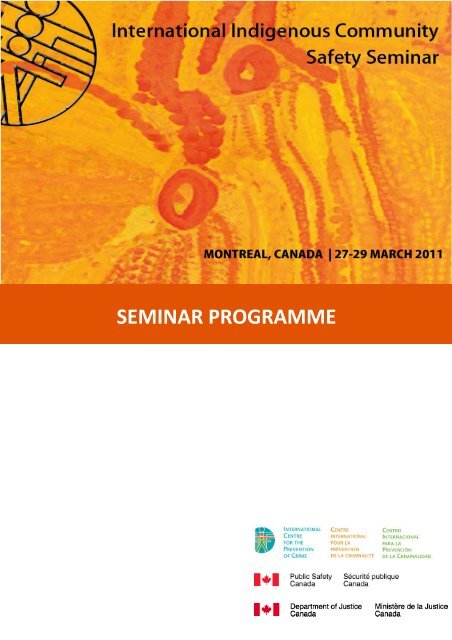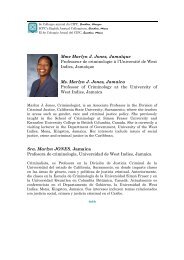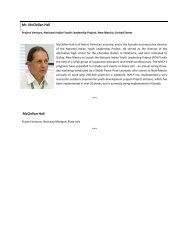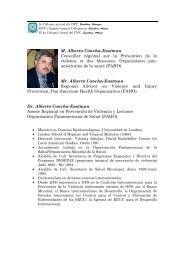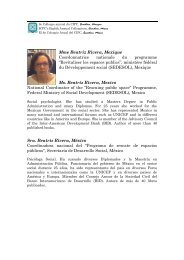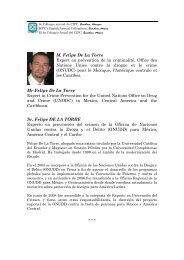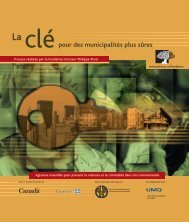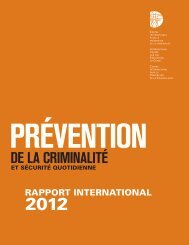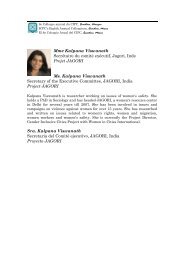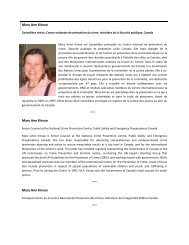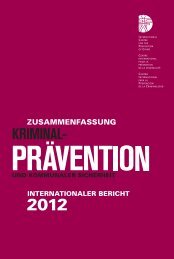seminar programme - International Centre for the Prevention of Crime
seminar programme - International Centre for the Prevention of Crime
seminar programme - International Centre for the Prevention of Crime
Create successful ePaper yourself
Turn your PDF publications into a flip-book with our unique Google optimized e-Paper software.
INTERNATIONAL INDIGENOUS COMMUNITY SAFETY SEMINAR 2
TABLE OF CONTENTSPRACTICAL INFORMATION 4ABOUT THE SEMINAR 6SEMINAR PROGRAMME 13PRESENTATION DESCRIPTION 15SPEAKER BIOGRAPHIES 20INTERNATIONAL INDIGENOUS COMMUNITY SAFETY SEMINAR 3
PRACTICAL INFORMATIONLocationHotel Omni Mont-Royal1050 Sherbrooke Street WestMontréal, QC H3A 2R6(514) 284-1110http://www.omnihotels.com/FindAHotel/MontRoyal.aspxThe 3-day Seminar will be held on <strong>the</strong> 2nd Floor <strong>of</strong> <strong>the</strong> Hotel Omni Mont-Royal (March 27-March 29).The Omni Mont-Royal <strong>of</strong>fer valet parking at a rate <strong>of</strong> $16.75 <strong>for</strong> 12 hours and $25.96 <strong>for</strong> 24 hours. Youcan park by yourself at a variable rate <strong>for</strong> 12 hours and $16.75 <strong>for</strong> 24 hours.AccomodationThe <strong>International</strong> <strong>Centre</strong> <strong>for</strong> <strong>the</strong> <strong>Prevention</strong> <strong>of</strong> <strong>Crime</strong> (ICPC) has negotiated rates <strong>for</strong> <strong>seminar</strong> delegatesat <strong>the</strong> Hotel Omni Mont-Royal. To view rates and book your accommodation, please visit ICPC website:http://www.crime‐prevention‐intl.org/Catering and dietary requirementsMorning break, lunch and afternoon break will be served each day.Please indicate to <strong>the</strong> Seminar coordinator be<strong>for</strong>e <strong>the</strong> event if you have any special dietaryrequirements.Cocktail ReceptionThe cocktail reception is open to all conferences delegates and will be held on Sunday, 27 March 2010on <strong>the</strong> 2nd Floor. The cocktail will start immediately after <strong>the</strong> keynote speaker’s presentation atapproximately 6.30 pm.Name tagsAll registered conference delegates will be issued with a name tag upon registration at <strong>the</strong> conference.INTERNATIONAL INDIGENOUS COMMUNITY SAFETY SEMINAR 4
Seminar evaluation <strong>for</strong>mIncluded in your conference papers you will find a conference evaluation <strong>for</strong>m. To assist ICPC in <strong>the</strong>planning <strong>of</strong> <strong>the</strong> future conferences, please complete <strong>the</strong> <strong>for</strong>m and return it at <strong>the</strong> registration deskprior to your departure from <strong>the</strong> event.More in<strong>for</strong>mationFor more in<strong>for</strong>mation on <strong>the</strong> <strong>International</strong> Indigenous Community Safety Seminar, please contact:Vivien Carli, Analyst and Project <strong>of</strong>ficer<strong>International</strong> <strong>Centre</strong> <strong>for</strong> <strong>the</strong> <strong>Prevention</strong> <strong>of</strong> <strong>Crime</strong>Phone: +1. 514.288.6731Email: vcarli@crime-prevention-intl.orgINTERNATIONAL INDIGENOUS COMMUNITY SAFETY SEMINAR 5
ABOUT THE SEMINARThe Seminar will be organized into Panel and Roundtable DiscussionsPanel DiscussionsSession I : Children and young peopleSession II : Urban Indigenous PopulationsSession III : Evaluation frameworksSession IV & V: Holistic approaches to safety (2 sessions)Film and Discussion : Third World CanadaSession VI : Wrap – Up and ReviewRoundtable DiscussionsFollowing each session, participants will take part in roundtable discussions in order to reflect on <strong>the</strong>presentations and/or engage in activities to help participants think about <strong>the</strong> following points:Are <strong>the</strong>re similarities in <strong>the</strong>se models and methodologies that reflect emerging orexisting trends and developments in your community/institution? What can we learnfrom <strong>the</strong> presentations and <strong>the</strong> processes involved – <strong>the</strong> challenges and opportunities?What can we take back from <strong>the</strong> presentations?Can <strong>the</strong>se models and methodologies be a good basis <strong>for</strong> collaboration acrosscommunities, cities, regions or between countries?Reflecting on <strong>the</strong> past 5-10 years, what makes a model or project work (ex.Participatory involvement, sustained funding, cross-over <strong>of</strong> disciplines, multi-sectorpartnerships, cross-government involvement)?INTERNATIONAL INDIGENOUS COMMUNITY SAFETY SEMINAR 6
Description <strong>of</strong> <strong>the</strong> SeminarICPC has an extensive history <strong>of</strong> work relating to community safety and Indigenous communities. Thishas included international comparative analysis <strong>of</strong> policies and practice 1 , organization <strong>of</strong> workshops onIndigenous <strong>the</strong>mes 2 , <strong>the</strong> establishment <strong>of</strong> a Virtual Network <strong>of</strong> stakeholders, and <strong>the</strong> production <strong>of</strong> onlineBulletins <strong>of</strong> initiatives and practice. For example, ICPC organized two international workshops in<strong>the</strong> context <strong>of</strong> <strong>the</strong> Aboriginal Research and Policy Conference in Ottawa March 9-12 th in 2009. Over <strong>the</strong>past 10 years, <strong>the</strong> organization has established contacts with many partners across Canada, inAustralia, New Zealand, Norway, South Africa, Peru and <strong>the</strong> United States, including Indigenous andnon-indigenous groups and organizations and policy makers, researchers and practitioners working onprevention initiatives with and <strong>for</strong> Indigenous communities.Given this experience, ICPC is organizing an international <strong>seminar</strong> to consider recent progress,obstacles and current and emerging approaches relating to community safety among Indigenouspopulations. 3 Key indigenous and non-Indigenous stakeholders from seven countries (Australia,Canada, Kenya, New Zealand, Norway, Peru and <strong>the</strong> United States) are taking part in <strong>the</strong> <strong>seminar</strong>, thatincludes representatives <strong>of</strong> government and non-government organizations, practitioners, researchers,policy makers, health and police services and local authorities. The <strong>seminar</strong> provides a space toexchange and reflect on developments over <strong>the</strong> past 5 to 10 years and to identify some <strong>of</strong> <strong>the</strong> keyissues, trends and developments to in<strong>for</strong>m future policy and practice. The <strong>seminar</strong> thus brings toge<strong>the</strong>rCanadian and international partners <strong>for</strong> a series <strong>of</strong> focused discussions and debate.Importance and Objectives <strong>of</strong> <strong>the</strong> SeminarThe <strong>seminar</strong> is a unique opportunity to develop knowledge across cultures and countries on existingtrends and interventions, and which brings toge<strong>the</strong>r research, policy and practice. It includes goodprevention practice and participatory interventions that have shown positive results in improvingsafety in Indigenous communities – both in terms <strong>of</strong> communities <strong>of</strong> people and <strong>of</strong> place.1<strong>Crime</strong> <strong>Prevention</strong> and Indigenous Communities: Current <strong>International</strong> Strategies and Programmes (ICPC, 2003), CommunitySafety Partnerships by and with Indigenous Peoples (ICPC, 2006), Community Safety and Indigenous Peoples: SharingKnowledge, Insights and Action (ICPC, 2009).2ICPC’s 6 th Colloquium in Canberra, Australia, <strong>the</strong> 2009 Aboriginal Policy and Research Conference in Ottawa, Canada, ICPC’s15 th Anniversary Colloquium in Montreal, Canada - Workshop 11.3With <strong>the</strong> financial support <strong>of</strong> <strong>the</strong> National <strong>Crime</strong> <strong>Prevention</strong> <strong>Centre</strong>, Public Safety Canada and Justice CanadaINTERNATIONAL INDIGENOUS COMMUNITY SAFETY SEMINAR 7
The <strong>seminar</strong> is intended to:1. Provide an opportunity and a space <strong>for</strong> <strong>the</strong> expertise-sharing and encourage exchange <strong>of</strong>diverse knowledge and tools.2. Highlight and identify innovative practice models and methodologies from differentsettings, regions and countries, and identify models <strong>of</strong> intervention, in<strong>for</strong>mation activitiesthat reduce and/or prevent incarceration and victimization <strong>of</strong> Indigenous peoples.3. Increase <strong>the</strong> capacity <strong>of</strong> key stakeholders to better in<strong>for</strong>m <strong>the</strong> current state and futureplanning <strong>of</strong> knowledge on indigenous well-being and community safety.4. Highlight challenges and trends and identify options to address <strong>the</strong> issues that Indigenouspeople face to help in<strong>for</strong>m future strategies.5. Identify opportunities across and between countries and fields <strong>of</strong> knowledge <strong>for</strong>Indigenous and non-Indigenous institutions and groups to work in partnership andpositive collaboration to address <strong>the</strong> issues.6. Draw attention to <strong>the</strong> marginalization and victimization <strong>of</strong> Indigenous peoples and <strong>the</strong>impact <strong>of</strong> safety issues on Indigenous communities across <strong>the</strong> world, including children,youth and women, and <strong>the</strong>ir intersection with cultural practices, health and livelihoods.7. Produce <strong>the</strong> proceedings <strong>of</strong> <strong>the</strong> <strong>seminar</strong> that reflect <strong>the</strong> inputs and outcomes <strong>of</strong> <strong>the</strong><strong>seminar</strong> to aid future strategies.Target ParticipantsThe <strong>seminar</strong> involves a group <strong>of</strong> invited participants who are key actors in <strong>the</strong> field in <strong>the</strong>ir countries.They include Indigenous and non-Indigenous practitioners, researchers, policy makers andrepresentatives <strong>of</strong> non-government organizations, as well as those from urban local authorities. All areactively involved in initiatives with Indigenous populations, and working on issues relating tocommunity safety. They could work in <strong>the</strong> field <strong>of</strong> community development, support services, youthservices, policing, housing and health, etc.INTERNATIONAL INDIGENOUS COMMUNITY SAFETY SEMINAR 8
Programme ContentSESSION I: Children and young peopleIndigenous populations are relatively young compared to non-indigenous populations. Indigenousyouth are <strong>of</strong>ten subjected to discrimination by <strong>the</strong> wider community and denied equal opportunities inemployment and education, and maybe have been <strong>for</strong>ced into child care. They face significant anddisproportionate levels <strong>of</strong> risks in areas such as youth justice, health and poverty. At <strong>the</strong> same time,young people are actively engaging in urban areas to make <strong>the</strong>ir communities safer places.The session on children and young people will explore <strong>the</strong> following questions:Given <strong>the</strong> high proportion <strong>of</strong> children and young people among Indigenous populations (inrural and urban areas), how are <strong>the</strong>ir voices being heard, and positive energy be harnessed?What is being done to respond to <strong>the</strong> needs <strong>of</strong> growing numbers <strong>of</strong> children and youth?What are <strong>the</strong> main issues regarding child care, and its relation to victimization and <strong>of</strong>fendingamong indigenous youth, and poor well-being (health) outcomes <strong>of</strong> young indigenousindividuals?What can we learn about <strong>the</strong> prevention <strong>of</strong> youth gang involvement or exit strategies <strong>for</strong>youth already involved in gangs?What is being done to increase <strong>the</strong> safety <strong>of</strong> girls and young women in Indigenouscommunities?What is <strong>the</strong> role <strong>of</strong> education in <strong>the</strong> prevention <strong>of</strong> future disadvantage <strong>of</strong> indigenous youth?What is being done to re<strong>for</strong>m <strong>the</strong> way how on-reserve children are being educated?What kinds <strong>of</strong> prevention approaches and projects are being developed by young people?→ How can positive youth development be promoted and what initiatives can streng<strong>the</strong>nand improve <strong>the</strong> range <strong>of</strong> protective factors among Indigenous youth?INTERNATIONAL INDIGENOUS COMMUNITY SAFETY SEMINAR 9
SEMINAR PROGRAMMEDAY 1 Sunday, March 27, 2011Time Conference Session Location16:30 Registration opens 2 nd Floor17:00 - 17:30 Welcome address – Paula Miraglia, Director General, <strong>International</strong> <strong>Centre</strong> <strong>for</strong> <strong>the</strong><strong>Prevention</strong> <strong>of</strong> <strong>Crime</strong> and Mary-Anne Kirvan, Senior Counsel, National <strong>Crime</strong> <strong>Prevention</strong><strong>Centre</strong>17:30 - 17:45 Opening Prayer – Alex (Sonny) Diabo, Elder, KahnawakeÉté17:45 - 18:30 Keynote address – Katharine Irngaut, Acting Director <strong>for</strong> Sisters in Spirit, NativeWomen's Association <strong>of</strong> CanadaBreaking <strong>the</strong> Silence: Missing and Murdered Aboriginal Women and Girls in Canada18:30 - 20:00 Cocktail reception AutomneDAY 2 Monday, March 28, 201109:00 - 11:00 Session I - Youth and Children09:00 - 09:20 McClellan Hall, Founder and Executive Director, National Indian Youth LeadershipProject, United States <strong>of</strong> AmericaProject Venture09:20- 09:40 Chris Heide and a youth, Coordinator <strong>of</strong> Making Connections <strong>for</strong> Youth,Pangnirtung, Nunavut, CanadaYouth intervention and diversion outreach program09:40 - 10:00 Jackie Anderson, Ma Mawi Wi Chi Itata <strong>Centre</strong>, Manitoba, CanadaÉtéThe Most at Risk - Innovative Programming <strong>for</strong> Aboriginal Children and Youth whomare victims <strong>of</strong> Sexual Exploitation10:00 - 10:20 Ted Nelson, Vice-President, National Indian Child Welfare Association(NICWA) Board <strong>of</strong> Directors,Indigenous Child Safety in <strong>the</strong> U.S. : A Tribal Perspective10:20 - 10:40 Elizabeth De Beurs, Principal (Tuakau Primary School), New ZealandSafe Schools/Safe Communities10:40 - 11:00 Morning Break FoyerÉté11:00 - 12:00 Roundtable discussionsAutomneHiver12:00 - 13:00 Lunch13:00 - 14:20 Session II - Urban Indigenous populations13:00 - 13:20 Jeff Cyr, Executive Director, National Association <strong>of</strong> Friendship <strong>Centre</strong>s, CanadaCanada’s Urban Indigenous Communities13:20 - 13:40 Nakuset, Executive Director, Native Women's Shelter, and Co-Chair Montreal UrbanAboriginal Strategy Network, CanadaThe Resilience <strong>of</strong> Urban AboriginalsÉté13:40 - 14:00 Miriam Jorgensen, Research Director <strong>for</strong> <strong>the</strong> Harvard Project on American IndianEconomic Development, U.S.The U.S. Urban Indigenous Population: Characteristics, Concerns, and GovernanceArrangements14:00 - 14:20 Julie-Ann Tomiak, Senior Policy Analyst, Assembly <strong>of</strong> First Nations, CanadaEnhancing Community Safety and Security <strong>for</strong> Urban First Nation Citizens14:20 - 15:20 Roundtable discussions ÉtéINTERNATIONAL INDIGENOUS COMMUNITY SAFETY SEMINAR 13
AutomneHiver15:20 -15:40 Afternoon Break Foyer15:40 - 17:00 Session III - Evaluation frameworksAndrea Johnston, CEO <strong>of</strong> Johnston Research Inc., Toronto, CanadaConducting meaningful evaluation; <strong>the</strong> Tending <strong>the</strong> Fire Evaluation FrameworkÉté17:00 - 17:30 Reflections and Closing Address ÉtéDAY 3 Tuesday, March 29, 2011Time Conference Session Location09:00 - 10:35 Session IV - Holistic approaches to safety09:00 - 09:2009:20 - 09:40Sharon Payne, Assistant Manager, Law and Justice Section, Aboriginal and TorresStrait Islander Commission, AustraliaPlace-based justice initiatives in AustraliaDr Marilyn Brewin, Research Programme Leader, Nga Pae o te Maramatanga, Maori<strong>Centre</strong> <strong>of</strong> Research Excellence, University <strong>of</strong> Auckland, New Zealand"By Maori <strong>for</strong> Maori" a whanau approachÉté09:40 - 10:00 Sandra Tucker, Manager, Abuse <strong>Prevention</strong> Policy and Programs, Pauktuutit InuitWomen <strong>of</strong> CanadaSomebody’s Daughter Model and <strong>the</strong> Inuit Shelter Training model10:00 -10:20 Agnes Leina, Program Manager <strong>of</strong> <strong>the</strong> Coalition on Violence Against Women(COVAW), KenyaViolence against Maasai women and girls10:20 -10:35 Question period10:35 - 10:55 Morning Break Foyer10:55 - 12:30 FILM - Third World CanadaAndree Cazabon, Filmmaker, Cazabon ProductionsThird World Canada Film presentation and DiscussionÉté12:30 - 13:30 Lunch13:30 - 15:10 Session V - Holistic approaches to safety13:30 - 13:50 Rodrigo Elizarrarás, MexicoDomestic, political and communitarian violence, and indigenous communities inMexico13:50 - 14:10 Laura Beacr<strong>of</strong>t , Research Manager , Australian Institute <strong>of</strong> Criminology, AustraliaRecent Research to Support Improved Community Safety <strong>for</strong> Indigenous People inAustralia14:10 - 14:30 Britt Elin Hætta Isaksen, Police Chief Inspector, Norway Police Directorate, NorwayRiding <strong>the</strong> Sami language roller coasterÉté14:30 - 14:50 Chief Stan Grier, Chief <strong>of</strong> Police, Tsuu T'ina Nation Police Service, CanadaCommunity Policing in Canada’s First Nations Communities from “Self-AdministeredFirst Nations Policing Services” – An Overview14:50 - 15:10 Alicia Abanto, Program Manager, Pueblos Indígenas de la Defensoría del Pueblo,PeruIndigenous peoples in Peru: Situation <strong>of</strong> <strong>the</strong>ir right to health, education, participation,land and natural resources15:10-16:10 Roundtable DiscussionÉtéAutomneHiver16:10 - 17:00 Session VII - Wrap – Up and Review17:00 - 17:20 Wrap-Up – Vivien Carli, Analyst and Project Officer, <strong>International</strong> <strong>Centre</strong> <strong>for</strong> <strong>the</strong><strong>Prevention</strong> <strong>of</strong> <strong>Crime</strong>Closing address – Paula Miraglia, Director General, <strong>International</strong> <strong>Centre</strong> <strong>for</strong> <strong>the</strong>Été<strong>Prevention</strong> <strong>of</strong> <strong>Crime</strong>17:20 - 17:30 Closing prayer – Alex (Sonny) Diabo, Elder, Kahnawake ÉtéINTERNATIONAL INDIGENOUS COMMUNITY SAFETY SEMINAR 14
PRESENTATION DESCRIPTIONBreaking <strong>the</strong> Silence: Missing and Murdered Aboriginal Women and Girls in CanadaKatharine Irngaut, Acting Director <strong>for</strong> Sisters In Spirit (SIS), Native Women’s Association <strong>of</strong>CanadaMissing and murdered Aboriginal women and girls is a national concern. The disproportionate number<strong>of</strong> those lost are having a ripple effect within families, communities, and <strong>the</strong> country. "Breaking <strong>the</strong>Silence" speaks to honour <strong>the</strong> lives lost, but to also address <strong>the</strong> experiences <strong>of</strong> violence andvulnerability felt by Aboriginal women and girls in Canada.Project VentureMcClellan Hall, Founder and Executive Director, National Indian Youth Leadership Project, New Mexico,U.S.Project Venture is an outdoors experiential youth development program designed <strong>for</strong> high-riskAmerican Indian youth. Project Venture aims to prevent substance use and related problems throughclassroom-based problem-solving and skill-building activities, outdoor adventure-based experientialactivities, adventure camps and treks, and community-oriented service learning. It has beenimplemented in over 20 states, and currently in Canada. The program relies on American Indiantraditional values to help youth develop positive self-concept, effective social skills, a communityservice ethic, internal locus <strong>of</strong> control, and increased decision making and problem solving skills.Youth intervention and diversion outreach programChris Heide, Coordinator <strong>of</strong> Making Connections <strong>for</strong> Youth, Pangnirtung, Nunavut, CanadaPangnirtung is a small village located a few degrees south <strong>of</strong> <strong>the</strong> Arctic Circle on Baffin Island in <strong>the</strong>Canadian Territory <strong>of</strong> Nunavut. Pangnirtung: Making Connections <strong>for</strong> Youth, has launched <strong>the</strong>innovative Youth Intervention and Diversion Outreach (YIDO) project under <strong>the</strong> Municipal Governmentand with a host <strong>of</strong> Federal and Territorial partner agencies. The target population includes 310 Inuitat-risk children and youth.INTERNATIONAL INDIGENOUS COMMUNITY SAFETY SEMINAR 15
The Most at Risk - Innovative Programming <strong>for</strong> Aboriginal Children and Youth whom arevictims <strong>of</strong> Sexual ExploitationJackie Anderson, Ma Mawi Wi Chi Itata <strong>Centre</strong>, Manitoba, CanadaThis presentation will illustrate <strong>the</strong> benefits <strong>of</strong> innovative culturally appropriate children in careprograms that focus on individual capacity building, while healing and nurturing <strong>the</strong> deep wounds leftby sexual exploitation. The presenter will share <strong>the</strong> importance <strong>of</strong> a traditional holistic Value BasedModel <strong>the</strong> programs uses.Indigenous Child Safety in <strong>the</strong> U.S. : A Tribal PerspectiveTed Nelson, Vice-President, National Indian Child Welfare Association (NICWA) Board <strong>of</strong>Directors, U.S.This presentation provides a brief overview <strong>of</strong> <strong>the</strong> American Indian/Alaska Native population in <strong>the</strong> U.S.and federal Indian policy. Mr. Nelson will also share specific in<strong>for</strong>mation on <strong>the</strong> manifestations <strong>of</strong>colonialism, <strong>the</strong> Indian Child Welfare Act, restorative justice, and <strong>the</strong> child safety system <strong>of</strong> his tribe,<strong>the</strong> Seminole Tribe <strong>of</strong> Florida. He will close with providing resources <strong>for</strong> learning more about <strong>the</strong>setopics.Canada's Urban Indigenous CommunitiesJeff Cyr, Executive Director, National Association <strong>of</strong> Friendship <strong>Centre</strong>s, CanadaThe National Association <strong>of</strong> Friendship <strong>Centre</strong>s is a nation-wide network <strong>of</strong> 117 Aboriginal run andmanaged urban community based service delivery organizations whose mandate is to meet <strong>the</strong>ongoing daily life needs <strong>of</strong> <strong>the</strong> Canadian urban Aboriginal population. The Canadian urban Aboriginalpopulation is composed <strong>of</strong> a combination <strong>of</strong> First Nations, Metis and Inuit peoples. The urbanpopulation is young with over 40% <strong>of</strong> this population being under age 25. The presentation will focuson <strong>the</strong> good work being done by <strong>the</strong> Friendship <strong>Centre</strong>.The Resilience <strong>of</strong> Urban AboriginalsNakuset, Executive Director, Native Women's Shelter, Montreal, CanadaThe presentation will include <strong>the</strong> many obstacles that urban Aboriginals face, some <strong>of</strong> it includesdomestic abuse, assault, intergenerational trauma, addiction, homelessness, racism, inequality,discrimination and various o<strong>the</strong>r health issues. It will outline how <strong>the</strong> urban aboriginal community took<strong>the</strong> initiative to unite, identify <strong>the</strong> myriad <strong>of</strong> issues and create sustainable solutions.INTERNATIONAL INDIGENOUS COMMUNITY SAFETY SEMINAR 16
The U.S. Urban Indigenous Population: Characteristics, Concerns, and GovernanceArrangementsMiriam Jorgensen, Research Director <strong>for</strong> <strong>the</strong> Harvard Project on American Indian EconomicDevelopment, U.S.Half <strong>of</strong> <strong>the</strong> U.S. Indigenous population resides in cities. New national data allow <strong>the</strong> best look yet at<strong>the</strong> population’s socio-economic characteristics, and a new peak organization gives stronger voice tourban Indians’ concerns. None<strong>the</strong>less <strong>the</strong>se urban populations still lack true “governing institutions.”Enhancing Community Safety and Security <strong>for</strong> Urban First Nation CitizensJulie Tomiak, Senior Policy Analyst, Assembly <strong>of</strong> First Nations, CanadaThe focus <strong>of</strong> this presentation is on <strong>the</strong> challenges in enhancing community safety and security <strong>for</strong> FirstNation citizens who reside in urban areas. The presentation focuses on <strong>the</strong> idea that a contextualra<strong>the</strong>r than a punitive approach is required to effectively support community safety throughaddressing <strong>the</strong> basic needs <strong>of</strong> urban First Nation citizens, streng<strong>the</strong>ning First Nations rights, andinvesting in First Nation governments.Place-based justice initiatives in AustraliaSharon Payne, Assistant Manager, Law and Justice Section, Aboriginal and Torres Strait IslanderCommission, AustraliaFrom inner city to remote communities <strong>the</strong> Indigenous population <strong>of</strong> Australia is very diverse, so onesize-fits-alldoes not work. This presentation explores some <strong>of</strong> <strong>the</strong> most successful initiatives,examining what works and why <strong>the</strong>y work."By Maori <strong>for</strong> Maori" a whanau approachMarilyn Tangi Ina McPherson (Marilyn Brewin), Research Programme Leader, Ngā Pae o teMāramatanga, New ZealandThis presentation will focus on <strong>the</strong> presenter’s role as Chair <strong>of</strong> <strong>the</strong> Safe Communities Foundation NZ, asan evaluator <strong>of</strong> NZ Communiy Injury <strong>Prevention</strong> Projects and <strong>the</strong> Evaluator <strong>of</strong> <strong>the</strong> Kia Piki Te Ora o teTaitamariki Maori Youth Suicide Strategy. It will outline ways to work effectively with a wide range <strong>of</strong>stakeholders and <strong>the</strong> successes and challenges <strong>of</strong> using a “participatory” approach to addressindigenous community safety.INTERNATIONAL INDIGENOUS COMMUNITY SAFETY SEMINAR 17
Somebody’s Daughter Model and <strong>the</strong> Inuit Shelter Training modelSandra Tucker, Manager <strong>of</strong> Abuse <strong>Prevention</strong> Policy and Programs, Pauktuutit Inuit Women <strong>of</strong>CanadaThe presentation will focus on <strong>the</strong> on <strong>the</strong> development and implementation <strong>of</strong> Inuit specific projects toaddress violence and abuse prevention. Sandra will be using <strong>the</strong> Somebody’s Daughter Model and <strong>the</strong>Inuit Shelter Training model as a means to demonstrate <strong>the</strong> integration <strong>of</strong> culture and psychoeducation and community mobilization to bring about change.Violence against Maasai women and girls in KenyaAgnes Leina, Program Manager <strong>of</strong> <strong>the</strong> Coalition on Violence Against Women (COVAW), KenyaThe presentation will focus on <strong>the</strong> issue <strong>of</strong> violence against Maasai women and girls in Kenya. Thepresentation will review <strong>the</strong> Maasai culture and <strong>the</strong> role <strong>of</strong> <strong>the</strong> women, <strong>for</strong>ms <strong>of</strong> violence againstwomen in Maasai communities, how <strong>the</strong>y handle it, and <strong>the</strong> role <strong>of</strong> <strong>the</strong> Government in preventing andameliorating <strong>the</strong> situation. The presentation will <strong>of</strong>fer recommendations.Domestic, political and communitarian violence, and indigenous communities in MexicoRodrigo Elizarraraz AlvarezThe presentation will outline <strong>the</strong> three most common types <strong>of</strong> violence within indigenous ruralcommunities in Mexico: domestic violence, communitarian violence, and drug-trafficking relatedviolence. It will explore <strong>the</strong> evolution <strong>of</strong> <strong>the</strong> indigenous political situation after <strong>the</strong> EZLN, in order toexplain <strong>the</strong> current situation <strong>of</strong> indigenous communities in Mexico. It will expose some successfulprojects that are helping to prevent violence and crime in some <strong>of</strong> <strong>the</strong>se communities.Recent Research to Support Improved Community Safety <strong>for</strong> Indigenous People in AustraliaLaura Beacr<strong>of</strong>t, Research Manager at <strong>the</strong> Australian Institute <strong>of</strong> CriminologyAll Australian governments have committed to improving community safety especially <strong>for</strong> Indigenouspeoples. To support this work <strong>the</strong> Australian Institute <strong>of</strong> Criminology has done various researchrelevant to improving community safety, and an overview <strong>of</strong> this will be provided. Importantly, thisincludes a study on homicides, per<strong>for</strong>mance evaluations <strong>of</strong> key services such as night patrols andsurveying Indigenous people on <strong>the</strong>ir perceptions <strong>of</strong> community safety. This research provides insightinto what needs to be done.INTERNATIONAL INDIGENOUS COMMUNITY SAFETY SEMINAR 18
Riding <strong>the</strong> Sami language roller coasterBritt Elin Hætta Isaksen, Police Chief Inspector with <strong>the</strong> Norwegian Police Directorate, NorwayBeing viewed as a safety risk, as a Sami person, is not a pleasant experience, but I have thought aboutit and have actually come to <strong>the</strong> conclusion that when I speak Sami in my work, it is not associatedwith a risk <strong>for</strong> anyone. My Norwegian speaking colleagues just have to accept this. I will always saywhat I need to if <strong>the</strong>re is something I believe my colleagues need to know immediately. There aremany things I will do differently when we are called out to Sami environments. I will make it clear tomy colleague that I most likely will speak Sami. I will translate when appropriate or immediately. I willdo everything to make my colleague feel secure in <strong>the</strong> situation, even if he or she does not understandwhat is being said.Indigenous peoples in Peru: Situation <strong>of</strong> <strong>the</strong>ir right to health, education, participation, land andnatural resources.Alicia Maribel Abanto Cabanillas, Program Leader <strong>of</strong> Pueblos Indígenas de la Defensoría delPueblo, PeruThe presentation will focus on <strong>the</strong> situation <strong>of</strong> Indigenous peoples in Peru, within <strong>the</strong> context <strong>of</strong> legalissues. Indigenous persons in Peru face tremendous challenges in relation to gaining access to health,education, participation, land and natural resources. There have been several successes, yet <strong>the</strong> journeycontinues.INTERNATIONAL INDIGENOUS COMMUNITY SAFETY SEMINAR 19
SPEAKER BIOGRAPHIESRodrigo Elizarraraz AlvarezRodrigo Elizarraraz Alvarez has a degree in Political Science and Ma<strong>the</strong>matiques from ITAM (Mexico,DF). He has a Master’s in Political Science from <strong>the</strong> New School <strong>for</strong> Social Research in New York. Hehas worked as a consultant and researcher <strong>for</strong> <strong>the</strong> government <strong>of</strong> Mexico. His research areas arepolitical representation <strong>of</strong> ethnic minorities, application <strong>of</strong> social policies <strong>for</strong> vulnerable persons, socialmobilization, and violence prevention policies in marginalized regions.Jackie Anderson,Ma Mawi Wi Chi Itata <strong>Centre</strong>, Manitoba, CanadaJackie Anderson is a Metis Woman from Winnipeg, Manitoba. For <strong>the</strong> last 14 years she has workedwith <strong>the</strong> Ma Mawi Wi Chi Itata <strong>Centre</strong>, in <strong>the</strong> Ojibway language means “We all work Toge<strong>the</strong>r to helpone ano<strong>the</strong>r”. She does program development <strong>for</strong> <strong>the</strong> children in care programs, in particular she hasdeveloped two safe homes <strong>for</strong> sexually exploited youth, Honoring <strong>the</strong> Spirits <strong>of</strong> Our Little Sisters andHOME- Hands <strong>of</strong> Mo<strong>the</strong>r Earth. She is <strong>the</strong> current Co-Chair <strong>for</strong> <strong>the</strong> Sexually Exploited YouthCommunity Coalition, participates on Senator Romeo Dallaire’s Roundtable meetings on <strong>the</strong>Commercial Sexual Exploitation <strong>of</strong> Children and Youth.Laura Beacr<strong>of</strong>tResearch Manager at <strong>the</strong> Australian Institute <strong>of</strong> CriminologyLaura Beacr<strong>of</strong>t is a Research Manager at <strong>the</strong> Australian Institute <strong>of</strong>Criminology. She manages <strong>the</strong> <strong>Crime</strong> and Populations team, which conductspractical research to assist vulnerable populations including victims <strong>of</strong>trafficking in persons crimes and Indigenous people. Ms Beacr<strong>of</strong>t is a lawyerwith experience in areas linked to crime reduction and prevention, havingworked at <strong>the</strong> frontline in <strong>the</strong> justice system, as a corporate regulator, infamily violence and homelessness prevention, and with communitiesincluding Indigenous, migrant communities and victims <strong>of</strong> violence.INTERNATIONAL INDIGENOUS COMMUNITY SAFETY SEMINAR 20
Alicia Maribel Abanto CabanillasProgram Leader <strong>of</strong> Pueblos Indígenas de la Defensoría del Pueblo, PeruAlicia Maribel Abanto Cabanillas is <strong>the</strong> Program Leader <strong>of</strong> Pueblos Indígenas de la Defensoría delPueblo in Peru. She studied Law at <strong>the</strong> National University and has a graduate degree in environmentallaw. She has experience working in human rights government oversight and supervision, and has heldnumerous positions concerning indigenous peoples’ rights. Alicia has presented at severalinternational events.Andrée CazabonCazabon ProductionsGemini nominee and inspirational speaker, Andrée Cazabon, recentlycompleted her fifth film, 3 rd World Canada on <strong>the</strong> conditions <strong>for</strong> childrenliving on remote First Nations reserve. Andree is an active volunteer onyouth-at-risk and youth in foster care projects. Championed by <strong>the</strong>Senators Foundation and <strong>the</strong> Max Keeping Foundation, she has helpedraised over $360,000 <strong>for</strong> Scholarships <strong>for</strong> youth in care.Jeff CyrExecutive Director, National Association <strong>of</strong> Friendship <strong>Centre</strong>s, CanadaFor more than a decade, Mr. Cyr focused his career providing strategicplanning and operational leadership within Aboriginal organizations suchas <strong>the</strong> Assembly <strong>of</strong> Manitoba Chiefs and <strong>the</strong> Manitoba Métis Federation.Within <strong>the</strong> Government <strong>of</strong> Canada, he has extensive experience workingwithin <strong>the</strong> Privy Council Office, Natural Resource Canada and <strong>the</strong> RoyalCanadian Mounted Police. He was recently appointed Executive Director<strong>of</strong> <strong>the</strong> National Association <strong>of</strong> Friendship <strong>Centre</strong>s. He is proud <strong>of</strong> hisMétis heritage and identifies as an urban Aboriginal person. He has aMaster <strong>of</strong> Arts in Political Studies/<strong>International</strong> Relations from <strong>the</strong>University <strong>of</strong> Manitoba.INTERNATIONAL INDIGENOUS COMMUNITY SAFETY SEMINAR 21
Stan C. GrierChief <strong>of</strong> Police, Tsuu T'ina Nation Police Service, Alberta, CanadaStan has been on <strong>the</strong> First Nations Chiefs <strong>of</strong> Police Association (FNCPA)Executive since June 2006, and effective June 2008 he was electedPresident <strong>of</strong> <strong>the</strong> FNCPA. Stan is currently a Director on <strong>the</strong> CanadianAssociation <strong>of</strong> Chiefs <strong>of</strong> Police Association (CACP), a Committee Memberon <strong>the</strong> National Joint Committee <strong>of</strong> Senior Criminal Justice Officials (NJC),and is a member <strong>of</strong> <strong>the</strong> Indian Country Law En<strong>for</strong>cement Section (ICLES) <strong>of</strong><strong>the</strong> <strong>International</strong> Association <strong>of</strong> Chiefs <strong>of</strong> Police (IACP).McClellan HallFounder and Executive Director, National Indian Youth Leadership Project, New Mexico, U.S.McClellan Hall is <strong>of</strong> Native American ancestry, and is <strong>the</strong> founder andexecutive director <strong>of</strong> <strong>the</strong> National Indian Youth Leadership Project. NIYLPhas implemented a very successful outdoors experiential youthdevelopment project-Project Venture, which has been implemented inover 20 states, and is currently being implemented in Canada.Chris HeideCoordinator <strong>of</strong> Making Connections <strong>for</strong> Youth, Pangnirtung, Nunavut, CanadaChris Heide is <strong>the</strong> Coordinator <strong>of</strong> Making Connections <strong>for</strong> Youth with <strong>the</strong>Hamlet <strong>of</strong> Pangnirtung. He lived in this Nunavut community in <strong>the</strong> 1980s,returned to live <strong>the</strong>re in 2007 and began as Coordinator that fall. Chrishas devoted much <strong>of</strong> his working life to <strong>the</strong> concerns <strong>of</strong> youth includingyears <strong>of</strong> exploring <strong>the</strong> use <strong>of</strong> drama in community development workingwith an incredible variety <strong>of</strong> community groups. In 2005 he was honouredwith <strong>the</strong> Gordon Foundation’s Award <strong>for</strong> Children and Youth in 2008chosen National Ambassador <strong>for</strong> Safety Community Service <strong>for</strong> a <strong>the</strong>atreproject on teen suicide.INTERNATIONAL INDIGENOUS COMMUNITY SAFETY SEMINAR 22
Katharine IrngautActing Director <strong>for</strong> Sisters In Spirit (SIS), Native Women’s Association <strong>of</strong> CanadaKatharine Irngaut is presently Acting Director <strong>for</strong> Sisters In Spirit (SIS),a department <strong>of</strong> <strong>the</strong> Native Women’s Association <strong>of</strong> Canada (NWAC).While her career started in Inuit film and television production, shebecame very involved in <strong>the</strong> movement to end violence againstAboriginal women and girls in Canada. She is now dedicated toworking with families, communities, police, and service providers tohonour those lives that have been touched by tragedy.Britt Elin Hætta IsaksenPolice Chief Inspector with <strong>the</strong> Norwegian Police Directorate, NorwayBritt Elin Hætta Isaksen is a Police Chief Inspector with <strong>the</strong> Norwegian Police Directorate and aMaster’s student. She is 46 years old and currently lives in Tana, in <strong>the</strong> nor<strong>the</strong>rn part <strong>of</strong> Norway. She isSami and her first language is Sami.Andrea L.K. JohnstonCEO <strong>of</strong> Johnston Research Inc., Toronto, CanadaAndrea Johnston is <strong>the</strong> CEO <strong>of</strong> Johnston Research Inc. She is a member <strong>of</strong><strong>the</strong> Chippewas <strong>of</strong> Nawash First Nation and University <strong>of</strong> Toronto Graduatewith a B.A. in Sociology. She has an extensive background in evaluation <strong>of</strong>programming directed at, designed, and delivered by Aboriginal peoples.She has worked as a summative and <strong>for</strong>mative program evaluator andresearcher <strong>for</strong> over 14 years in <strong>the</strong> fields <strong>of</strong> Aboriginal health,children’s/youth education, social welfare, and labour market programs.INTERNATIONAL INDIGENOUS COMMUNITY SAFETY SEMINAR 23
Miriam JorgensenResearch Director <strong>for</strong> <strong>the</strong> Harvard Project on American Indian Economic Development, U.S.Miriam Jorgensen (Ph.D., Harvard University) is Research Director <strong>for</strong> <strong>the</strong>Harvard Project on American Indian Economic Development and <strong>for</strong> itssister program, <strong>the</strong> Native Nations Institute at <strong>the</strong> University <strong>of</strong> Arizona.She is a co-author <strong>of</strong> The State <strong>of</strong> <strong>the</strong> Native Nations: Conditions under U.S.Policies <strong>of</strong> Self-Determination (Ox<strong>for</strong>d University Press, 2008) and editorand co-author <strong>of</strong> Rebuilding Native Nations: Strategies <strong>for</strong> Governance andDevelopment (University <strong>of</strong> Arizona Press, 2007).Agnes LeinaProgram Manager <strong>of</strong> <strong>the</strong> Coalition on Violence Against Women (COVAW), KenyaAgnes Leina is <strong>the</strong> Program Manager <strong>of</strong> <strong>the</strong> Coalition on Violence AgainstWomen (COVAW) in Kenya. She received a certificate in <strong>International</strong>Development from <strong>the</strong> University <strong>of</strong> Birmingham- Selly Oak colleges in <strong>the</strong>U.K., and has a Masters Degree in Rural Sociology and CommunityDevelopment from <strong>the</strong> University <strong>of</strong> Nairobi, in Kenya. She has worked in<strong>the</strong> nor<strong>the</strong>rn part <strong>of</strong> Kenya with rural Samburu and Maasai women with awide experience in community development and capacity building <strong>of</strong>communities to end and prevent violence against women.Marilyn Tangi Ina McPhersonResearch Programme Leader, Ngā Pae o te Māramatanga, New ZealandDr McPherson (who is also known as Dr Brewin) completed her Bachelor <strong>of</strong> Arts with a double major inGeography at <strong>the</strong> University <strong>of</strong> Auckland in 1976. In 2003, she completed her PhD within <strong>the</strong>Department <strong>of</strong> Community Health and <strong>the</strong> Faculty <strong>of</strong> Medicine at <strong>the</strong> University <strong>of</strong> Auckland. AsResearch Programme Leader, Marilyn manages <strong>the</strong> <strong>Centre</strong>’s research funding rounds, both contestableand non contestable, and provides leadership and guidance to mid-career and senior Maoriresearchers.INTERNATIONAL INDIGENOUS COMMUNITY SAFETY SEMINAR 24
Italo García MurayariAIDESEP, PeruItalo García Murayari is from <strong>the</strong> Vista Alegre community in Rio Ucayali, <strong>the</strong>Ucayali Region in Peru. He lives in San Juan, near <strong>the</strong> town <strong>of</strong> Pucallpa(Shipibo community). He began his work in activism with <strong>the</strong> Federation <strong>of</strong>Indigenous communities <strong>of</strong> Ucayali. His main work with <strong>the</strong> Federation wasmaintaining a network across all 250 Shipibo communities located in <strong>the</strong>region. He was involved in a local radio station, providing in<strong>for</strong>mation onevents concerning indigenous communities. Since 2009, he has beeninvolved in <strong>the</strong> national organization AIDESEP and <strong>of</strong>ten travels to <strong>the</strong>interior <strong>of</strong> <strong>the</strong> Amazon to provide workshops on capacity-building.NakusetExecutive Director, Native Women's Shelter, Montreal, CanadaNakuset is from <strong>the</strong> Cree Nation <strong>of</strong> Lac La Ronge, in Saskatchewan. Shewas adopted by a Jewish family as a child. This experience as a nativeadoptee has given her <strong>the</strong> insight and she currently sits on a committeewith Batshaw Youth and Family Services to help support Aboriginal childrenin care. She has been working at <strong>the</strong> Native Women's Shelter since 1999,beginning as a Front line worker and worked her way up to ExecutiveDirector. She is currently <strong>the</strong> co-president <strong>of</strong> <strong>the</strong> Montreal UrbanAboriginal Community Strategy. She is <strong>the</strong> proud mo<strong>the</strong>r <strong>of</strong> two youngboys, Kistin and Mahkisis.Ted NelsonVice-President, National Indian Child Welfare Association (NICWA) Board <strong>of</strong> Directors, U.S.Ted Nelson is a Seminole tribal member living in Hollywood, Florida. He is a tribally appointed childwelfare advocate <strong>for</strong> <strong>the</strong> Seminole Tribe. Ted received his bachelor’s degree from <strong>the</strong> Union Institute inFlorida and went on to receive his master’s degree in social work from Barry University in Florida. Tedis a PhD candidate in <strong>the</strong> Barry University social work program. He has significant experience with <strong>the</strong>development <strong>of</strong> foster care systems and intertribal and tribal government-to-governmentnegotiations. As a board member <strong>of</strong> <strong>the</strong> National Indian Child Welfare Association (NICWA) since 2005,Ted has contributed in a variety <strong>of</strong> ways to <strong>the</strong> Portland, Oregon-based association, adding uniquely toits growth, development, and mission. He currently serves on NICWA’s Program and Public PolicyCommittees.INTERNATIONAL INDIGENOUS COMMUNITY SAFETY SEMINAR 25
Sharon PayneAssistant Manager, Law and Justice Section, Aboriginal and Torres Strait Islander Commission,AustraliaSharon Payne is an Aboriginal woman who has 25 years <strong>of</strong> experience injustice issues including as <strong>the</strong> government <strong>of</strong>ficer <strong>for</strong> <strong>the</strong> RoyalCommission into Aboriginal Deaths in Custody and as <strong>the</strong> CEO <strong>of</strong> threeAboriginal Legal Services. Recent projects have included <strong>the</strong>development <strong>of</strong> an Aboriginal Justice Agreement in <strong>the</strong> ACT and earlyintervention programs <strong>for</strong> Aboriginal & Torres Strait Islander youth.Sharon has also produced a number <strong>of</strong> publications including anIndigenous Cultural Guide <strong>for</strong> Family Law Practitioners, assisted in settingup Circle Sentencing Courts in NSW, ACT and <strong>the</strong> NT.Julie TomiakSenior Policy Analyst, Assembly <strong>of</strong> First Nations, CanadaJulie Tomiak has worked as a Senior Policy Analyst at <strong>the</strong> Assembly <strong>of</strong>First Nations since 2009. She is a Ph.D. Candidate (ABD) at CarletonUniversity. Her research looks at urban Indigenous governance andstruggles <strong>for</strong> self-determination in Ottawa and Winnipeg. Julie is <strong>of</strong>Algonquin, French and German descent.Sandra TuckerManager <strong>of</strong> Abuse <strong>Prevention</strong> Policy and Programs, Pauktuutit Inuit Women <strong>of</strong> CanadaSandra Tucker is <strong>the</strong> Manager <strong>of</strong> Abuse <strong>Prevention</strong> Policy and Programs at Pauktuutit Inuit Women <strong>of</strong>Canada, <strong>the</strong> national representative organization <strong>for</strong> Inuit women in Canada. She holds a Mastersdegree in Counseling with a specialization in trauma and critical incident response counseling. For <strong>the</strong>last twenty five years she has worked in direct front line services in <strong>the</strong> area <strong>of</strong> violence and abuseprevention. Sandra has significant experience working with Aboriginal groups (First Nations, Métis andInuit) as well as all age groups.INTERNATIONAL INDIGENOUS COMMUNITY SAFETY SEMINAR 26
INTERNATIONAL INDIGENOUS COMMUNITY SAFETY SEMINAR 27
INTERNATIONAL INDIGENOUS COMMUNITY SAFETY SEMINAR 28


